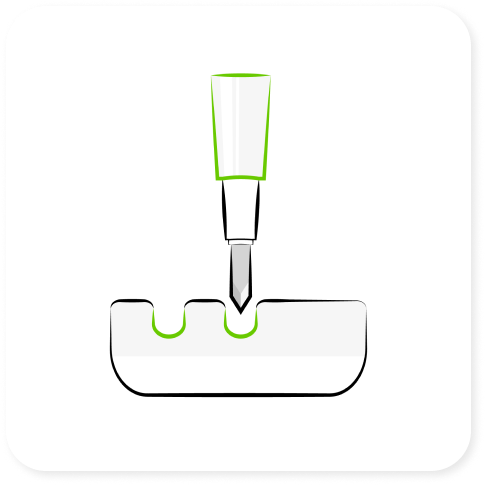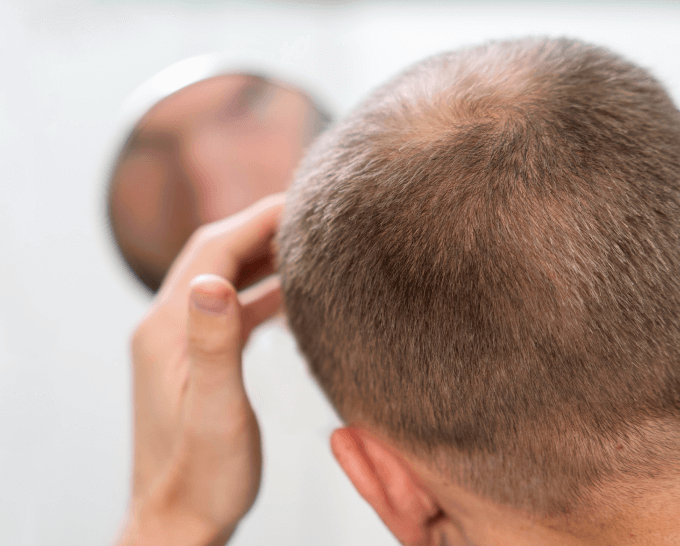Rompiendo Mitos: Los Implantes Capilares al Descubierto
IMPLANTES CAPILARES Rompiendo Mitos: Los Implantes Capilares al Descubierto La caída del cabello es una preocupación común que puede afectar la autoestima
The FUE microimplantation is an outpatient and minimally invasive procedure performed under local anesthesia.
Individual hair follicles are extracted from the back and sides of the head, eliminating the need for stitches.
Subsequently, these follicles are classified based on the number of hairs they contain and are carefully transplanted into areas with hair loss. Microchannels are created for this purpose through incisions using a sapphire-tipped scalpel.




Your own hair.
Once recovered, the scars are not visible and the implant is imperceptible to the human eye.


No complications. The procedure lasts between 5 and 8 hours and soon after you can resume all your activities.


The transplanted hair grows normally and lasts a lifetime.
The FUE microimplantation is an outpatient and minimally invasive procedure performed under local anesthesia.
Individual hair follicles are extracted from the back and sides of the head, eliminating the need for stitches.
Subsequently, these follicles are classified based on the number of hairs they contain and are carefully transplanted into areas with hair loss. Microchannels are created for this purpose through incisions using a sapphire-tipped scalpel.








Design and preparation
for the surgery
In the design room the previous shaving is performed, as well as the marking of the surgical plan on the scalp. You will be able to talk to your doctor and have an active voice in the design of your hair implant.


Extraction of follicular units
After applying local anesthesia in the donor area, we begin to extract the follicles from the same site, using special instruments. It is key at this stage to extract these follicular units uniformly to ensure that later this area does not have visible differences in density.


Classification
Follicle
Not all follicles are the same. Each one can contain from 1 to 4 hairs, so our team separates them using stereoscopic microscopes. This is important, as each type of follicle will have a specific location on the scalp to achieve the most natural result.


Incisions
This is the most relevant stage of the hair transplant, and where the doctor's expertise stands out the most when defining the depth and angle of each of the cuts. At Medical Hair, we use a sapphire-tipped scalpel that, unlike surgical steel, allows more density and generates less damage to your scalp.


implantation
Unit
The team will begin to carefully place the follicular units. Follicles with one hair usually go in the front part to achieve a more natural front line, while follicles with 2, 3 and 4 hairs are placed in the most unpopulated areas to improve density.


Recovery and
aftercare
Once the surgery is finished, you will go to a private recovery area. Your doctor will explain to you the necessary care to improve the success rate of the hair transplant and will provide you with all the required elements. From your check-up the day after surgery until one year after, we will see you for regular check-ups.


Design and preparation
for the surgery:
In the design room the previous shaving is performed, as well as the marking of the surgical plan on the scalp. You will be able to talk to your doctor and have an active voice in the design of your hair implant.


Extraction of
follicular units
After applying local anesthesia in the donor area, we begin to extract the follicles from the same site, using special instruments. It is key at this stage to extract these follicular units uniformly to ensure that later this area does not have visible differences in density.


Classification
Follicle
Not all follicles are the same. Each one can contain from 1 to 4 hairs, so our team separates them using stereoscopic microscopes. This is important, as each type of follicle will have a specific location on the scalp to achieve the most natural result.


Incisions
This is the most relevant stage of the hair transplant, and where the doctor's expertise stands out the most when defining the depth and angle of each of the cuts. At Medical Hair, we use a sapphire-tipped scalpel that, unlike surgical steel, allows more density and generates less damage to your scalp.


implantation
Unit
The team will begin to carefully place the follicular units. Follicles with one hair usually go in the front part to achieve a more natural front line, while follicles with 2, 3 and 4 hairs are placed in the most unpopulated areas to improve density.


Recovery and
aftercare
Once the surgery is finished, you will go to a private recovery area. Your doctor will explain to you the necessary care to improve the success rate of the hair transplant and will provide you with all the required elements. From your check-up the day after surgery until one year after, we will see you for regular check-ups.










The use of sapphire in the FUE hair transplant technique is the latest advance in the sector, Medical Hair being the first to work with the sapphire blade in Argentina.
In this technique, fine sapphire blades are used which, thanks to their V-shape, allow to precisely determine the direction and natural angle of the transplanted hair growth.




Easier to make smaller incisions with better follicle implantation.


Ideal for patients with a more severe degree of baldness, allowing for more hair to be placed on the same surface.


Since it is a stone material, there is less risk of allergic reactions, accelerating the healing process and reducing post-transplant swelling.
















Before providing a price, the first thing to do is to be evaluated by one of our doctors in a free consult. After evaluating your type of baldness and validating that you are a candidate for a hair transplant, we will provide you with an estimate for the treatment.
A trained physician is responsible for carrying out the surgical plan and is present at all key stages of the process. However, as thousands of follicles are implanted, several people are needed. That is why there is always a team of 2 to 3 instrumentalists working in the phases of extraction, classification and implantation of the hair.
Except for a few moments during the extraction phase, where the position is more limited, you can do some activities that make the process more enjoyable. Our patients often watch television, listen to their favorite music or use their cell phone.
For the first few days we will give you a post-operative kit along with the indications for the hygiene and care of the scalp. We will schedule an appointment for the first washings in our center. Then, during the first year, you will have regular check-ups with your doctor, where you will be able to assess your evolution.


















IMPLANTES CAPILARES Rompiendo Mitos: Los Implantes Capilares al Descubierto La caída del cabello es una preocupación común que puede afectar la autoestima
IMPLANTES CAPILARES Guía completa sobre Implantes Capilares: Todo lo que necesitás saber. Tu cabello natural y para siempre. Conocé el procedimiento paso
MESOTERAPIA Guía Completa sobre el Finasteride para la Pérdida de Cabello El finasteride ha surgido como una opción efectiva para combatir la